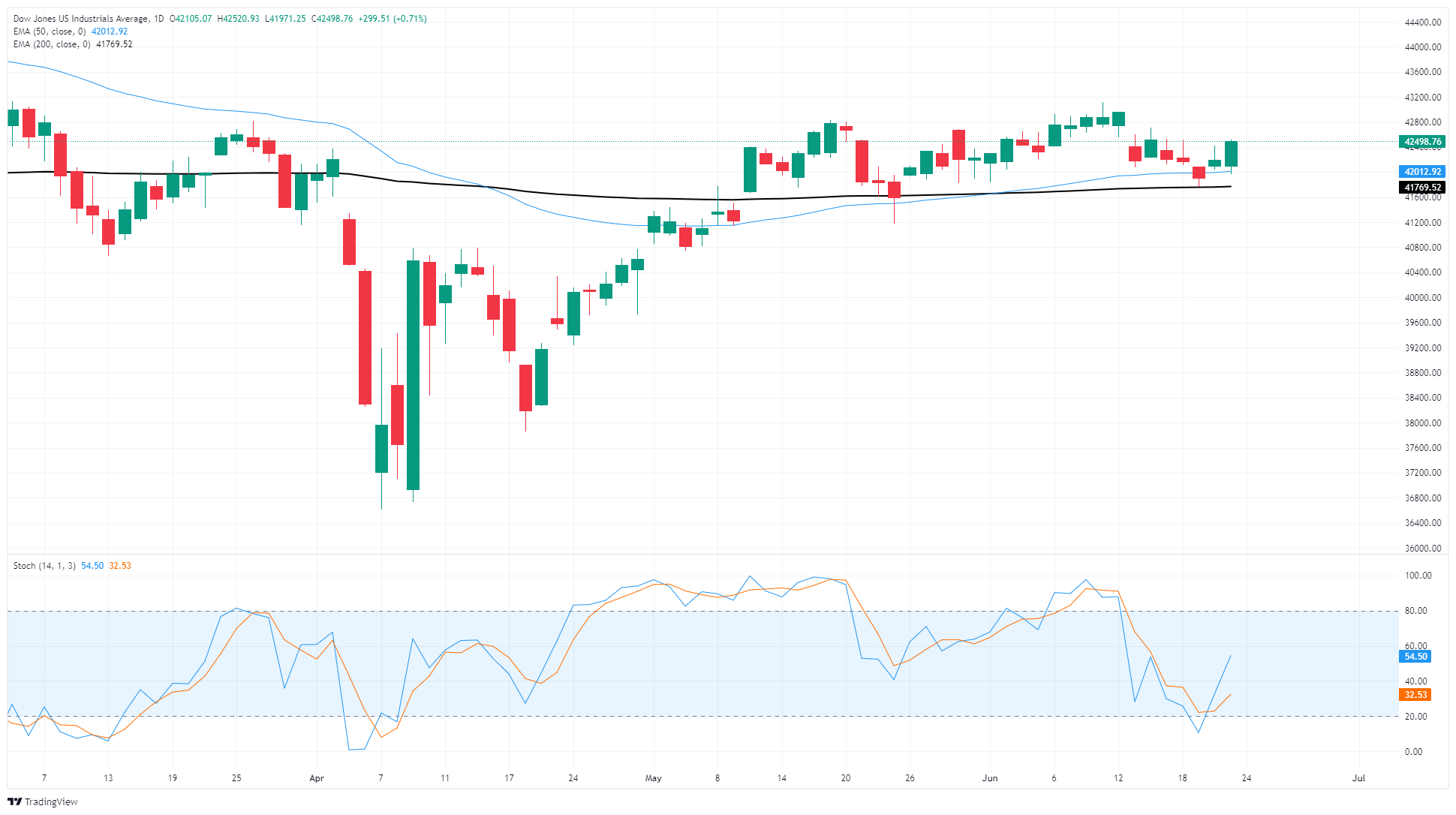Dow Jones Industrial Average roils as investors brace for rising Middle East tensions
- The Dow Jones rose slightly on Monday, as equities shrugged off weekend turmoil.
- The upbeat mood didn’t last long, as stock market volatility rose on further Middle East escalation.
- Iran has retaliated against US assets in Iraq and Qatar following the Trump administration’s missile strikes over the weekend.
The Dow Jones Industrial Average (DJIA) whipsawed on Monday, churning as investors reacted to headlines that Iran had lashed out at US military assets in the Middle East in retaliation for the weekend’s missile strikes ordered by the Trump administration. Equity markets have moved the goalposts on hoping for a de-escalation in the region, or at least that downside knock-on effects for the US economy will spur the Federal Reserve (Fed) into rate cuts sooner rather than later.
The US launched a series of missile strikes on what were believed to be Iranian nuclear facilities over the weekend. The Trump administration circumvented congressional approval to launch the strikes, a move that will likely draw political backlash within the US government in the weeks to come. Iran responded with target missile strikes against a US Air Force base in Qatar on Monday.
Markets initially roiled in the early hours, with investors fearing a possible closing of the Strait of Hormuz by Iran. Roughly one-fifth of global Crude Oil production flows through the strait, and equity markets were concerned about a possible supply chain shock. Despite the rising tensions, and the US appearing to reverse President Trump’s campaign promise of avoiding getting involved in foreign conflicts, investors are shaking off bearish sentiment. Markets are banking on the Middle East scenario remaining contained for the time being, and there are hopes that a bit of trade turmoil could hinder the US economy enough to prompt the Fed into a fresh round of rate cuts.
Read more stock news: US stocks downplay Iran retaliation concerns as indices edge higher
Dow Jones price forecast
After a rocky start to the trading week, the Dow Jones Industrial Average is pushing back into bullish territory and catching a bullish bounce from the 50-day Exponential Moving Average (EMA) near the 42,000 major price handle. The Dow is clawing back into a near-term congestion zone, climbing around 300 points on Monday. Price action remains capped below 43,000 for the time being, and a sustained push back into the high side will first need to make a firm break of the 42,500 level.
Dow Jones daily chart

Dow Jones FAQs
The Dow Jones Industrial Average, one of the oldest stock market indices in the world, is compiled of the 30 most traded stocks in the US. The index is price-weighted rather than weighted by capitalization. It is calculated by summing the prices of the constituent stocks and dividing them by a factor, currently 0.152. The index was founded by Charles Dow, who also founded the Wall Street Journal. In later years it has been criticized for not being broadly representative enough because it only tracks 30 conglomerates, unlike broader indices such as the S&P 500.
Many different factors drive the Dow Jones Industrial Average (DJIA). The aggregate performance of the component companies revealed in quarterly company earnings reports is the main one. US and global macroeconomic data also contributes as it impacts on investor sentiment. The level of interest rates, set by the Federal Reserve (Fed), also influences the DJIA as it affects the cost of credit, on which many corporations are heavily reliant. Therefore, inflation can be a major driver as well as other metrics which impact the Fed decisions.
Dow Theory is a method for identifying the primary trend of the stock market developed by Charles Dow. A key step is to compare the direction of the Dow Jones Industrial Average (DJIA) and the Dow Jones Transportation Average (DJTA) and only follow trends where both are moving in the same direction. Volume is a confirmatory criteria. The theory uses elements of peak and trough analysis. Dow’s theory posits three trend phases: accumulation, when smart money starts buying or selling; public participation, when the wider public joins in; and distribution, when the smart money exits.
There are a number of ways to trade the DJIA. One is to use ETFs which allow investors to trade the DJIA as a single security, rather than having to buy shares in all 30 constituent companies. A leading example is the SPDR Dow Jones Industrial Average ETF (DIA). DJIA futures contracts enable traders to speculate on the future value of the index and Options provide the right, but not the obligation, to buy or sell the index at a predetermined price in the future. Mutual funds enable investors to buy a share of a diversified portfolio of DJIA stocks thus providing exposure to the overall index.

